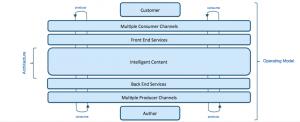- Content Engine Explained
- Content Engine Blueprint
- Content Engine Operationalisation
Well, thank you for sticking around for the third and final post in the series where we share a few tips on content engine operationalisation.
The first post in this content engine series highlighted the top ten content challenges faced by organisations looking to deliver scaleable personalised experiences. We followed up with a second post that outlined a content engine blueprint to address those challenges. We conclude the series with a few practical tips to operationalise your own content engine.
Content Engine Operationalisation
Before we operationalise, let’s back up a little here with a couple of scene setting questions and answers. First of all, why do we need a content engine?
To make content accessible and scaleable across the enterprise to create personalised experiences.
Making content accessible and scaleable means understanding who needs it, in what form, how they intend to use it, and defining success in measurable terms for effective content management. So what are the constituent parts of a content engine?
Our blueprint of a content engine highlighted the need for a performance framework, operating model and supporting content architecture.
Communication is fluid and content is communication. So we must continually optimise our content to maintain meaningful conversations with customers. To stay relevant. This requires quantifiable metrics to measure successful content outcomes. Everything we do with content forms part of a broader operating model for effective communication.
From creation to curation, configuration to compliance, content must flow like water down multiple channels. In this highly connected and always on world, liquid content needs to be structured and described in ways that enables it to be accessible everywhere it needs to be. We design for content using architecture. Our content engine blueprint ties performance, operating model and architecture together.
So let’s assume you have this, how do you operationalise the content engine? How do you bring the various parts of the blueprint to life?
Content Engine @ Work
There are a lot of things to consider when trying to operationalise a content engine within your organisation. Here are a few lumpy items to think about:
- Consumption and Production. We all consume and produce content in order to participate in meaningful conversations. The challenge is really understanding the value exchanged through these meaningful interactions between all participants the business ecosystem. These are typically mapped out as multi-channel consumer journeys. Carefully seeking better engagement at every touchpoint and delivering the best experience at that moment on interaction. However, these interactions rarely bring into play how agencies, partners and vendors engage within that business ecosystem. Your content engine must consider these enterprise players as part of these multi-channel journey definitions.
- To operationalise your content engine, expand your journey mappings to include all the key players within the business ecosystem that consume and produce content.
- Think Big, Start Small. Please, no more big bangs. Take a very specific use case and understand the value exchange between each and every producer and consumer. Be clear on who forms part of your immediate business ecosystem. Don’t try and do this with all participants. Focus on a single, meaningful interaction. Be task-oriented. Then apply the content engine blueprint to that.
- To operationalise your content engine, define success with content (performance framework), what tasks need to be completed (operating model), and make content intelligent to serve those tasks (content architecture).
- Channels. Channels are bi-directional pipes that transport content from A to B. Consumer channels are those on the front-line that engage directly with your target audience. Producer channels make up the back-line within the business where enterprise interactions take place. The same technology can span both front and back lines. For example, a CMS captures content in the back-line from content producers within agencies and push the resultant content out to consumers via web-sites and mobile apps in the front-line. The CMS also captures user-generated content from Facebook, blogs, Instagram in the front-line and pulls it back into the enterprise through APIs living within the back-line.
- To operationalise your content engine, design your producer and consumer channels as part of a wider content operating model that enable content to flow like water throughout the ecosystem.
- Services. Services are things we do to content entering and exiting channels. For example, back end services ingest, translate, tag, review, index, verify, and repurpose content originating from producer channels to ensure content remains intelligent. Services are critical to the make up of the content engine as they provide repeatable and predictable ways to store and retrieve intelligent content across the enterprise.
- To operationalise your content engine, develop services that respect and enforce your content architecture and police and punish content flowing across both producer and consumer channels.
Series Summary
Well that’s it. Although we covered a lot of ground in this three part series, we have only really just scratched the surface. To recap:
- Content Engine Challenges. What are the key content challenges brands are facing when trying to personalise customer experiences?
- Content Engine Blueprint. What kind of solution and approaches are they to addressing these content challenges?
- Content Engine Operationalisation. How should you operationalise a content engine within your organisation?
We are by no means done. We continue to learn by doing. Our experiments yield varying results, in different organisations, with vastly different content needs. However, this is an area of fierce activity today. The need to be globally consistent and cost effective with content across multiple channels demands better solutions to hard content challenges. The content engine is just one of many approaches out there to fight the good fight.
Good luck people!
Cleve


